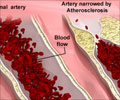Lower extremity ischemia, or abnormal circulation, occurs when arteries in the abdomen or pelvis narrow or become completely blocked by the build-up of plaque deposits. As a result, not enough oxygen-rich blood gets to the legs, causing cramps and pain, and making it difficult to walk or exercise. The iliac arteries are large arteries in the pelvis that supply blood to the legs.
Researchers say, stent placement should be considered the standard of care for treating patients with abnormal circulation due to the obstruction of the iliac arteries. Analyzing available data, the investigators found blood circulation improved with stents in 484 limbs out of 496 limbs of patients suffering from chronic leg ischemia. After five years, 86 percent of stented vessels remained open. After eight years, 84 percent remained open.A growing number of interventional radiologists are treating the condition with a less invasive stenting procedure. With this procedure, a catheter, or thin flexible tube, is inserted through a small incision in the skin and threaded to the site of the blocked artery. The vessel is pumped open by a tiny balloon, and the stent is inserted to hold open the blood vessel. Until the stent was introduced 10 years ago, the only way to open up such vessels was surgically bypassing the blockage with a healthy vein or artery.






